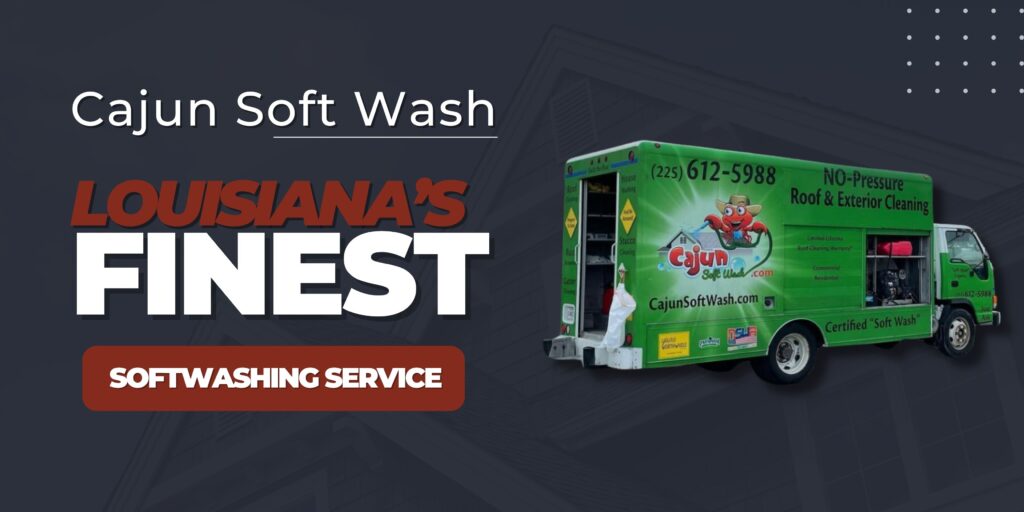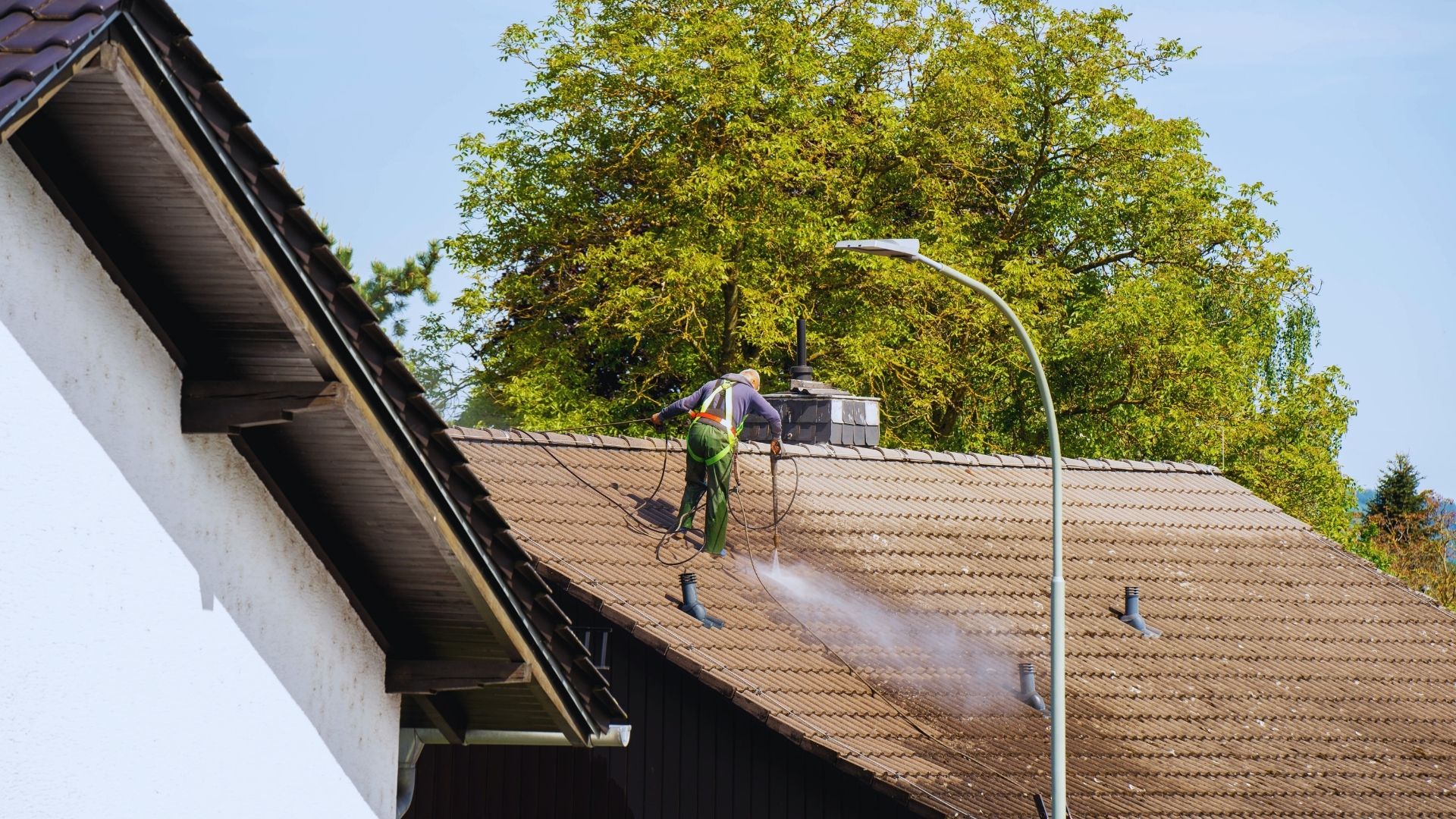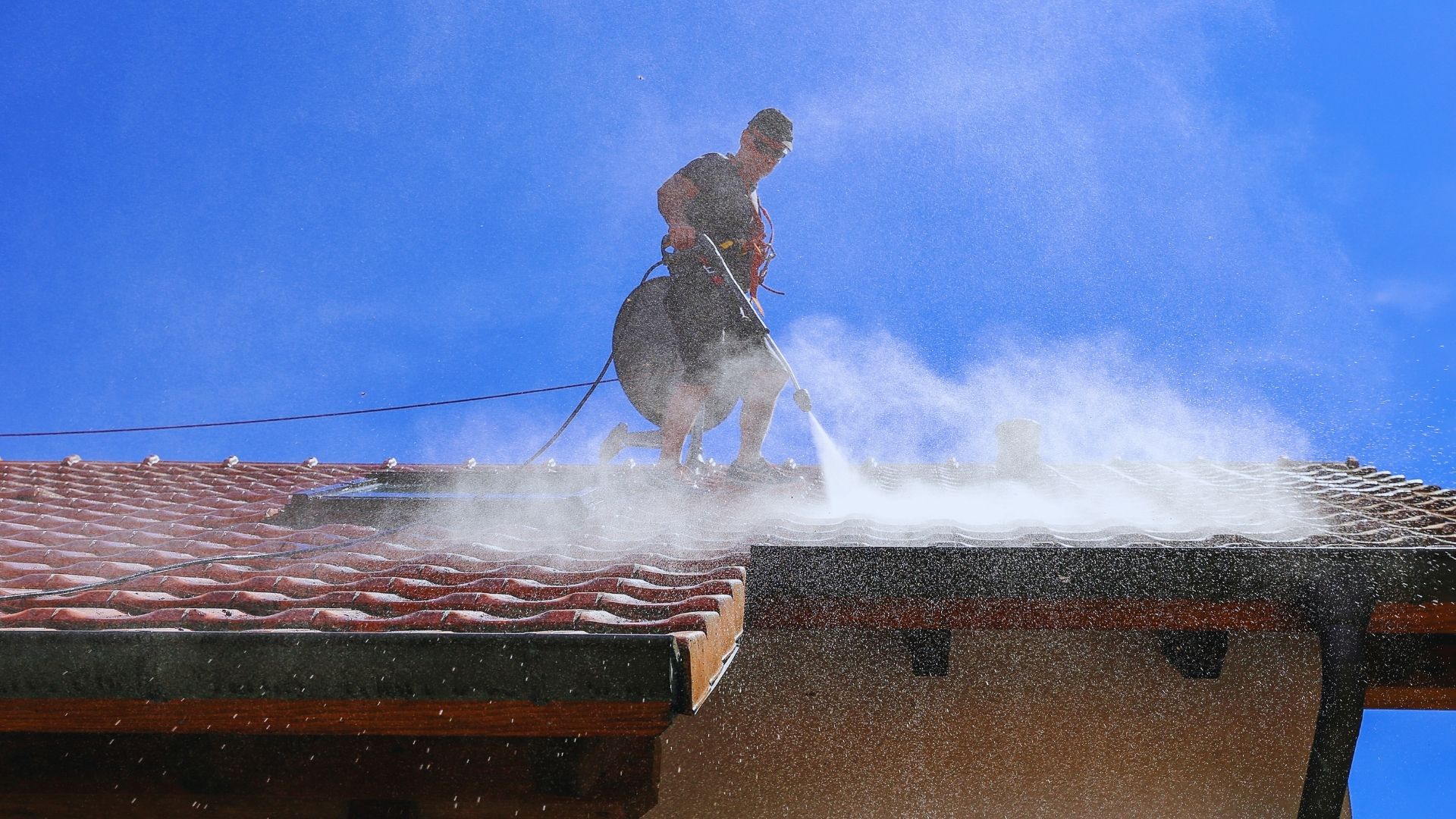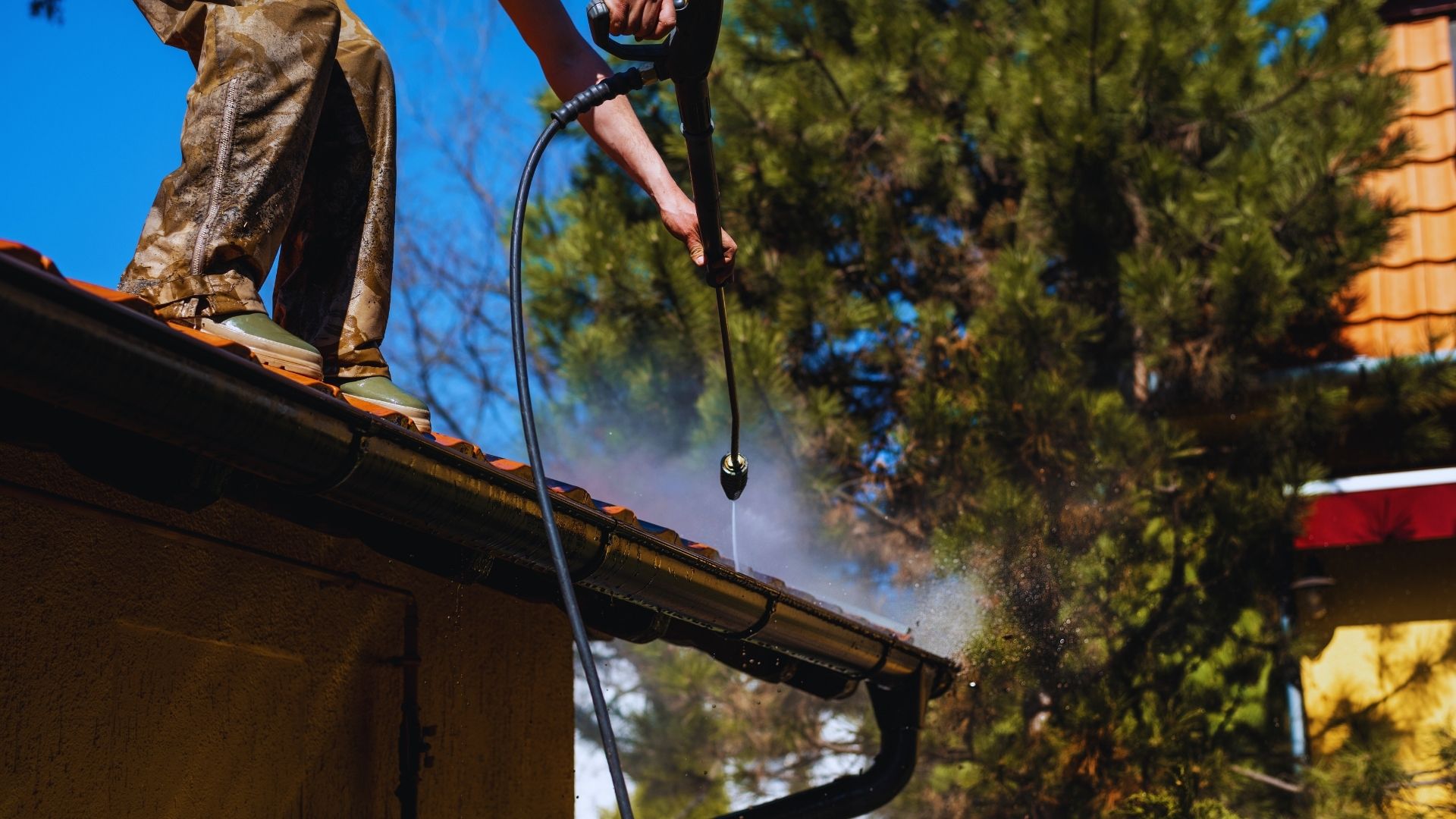Nobody wants to admit their awning looks like something from a science fiction movie, but in humid climates, mold happens fast. One week, homeowners are enjoying their patio, and the next, they’re staring up at green and black patches that make visitors wonder about housekeeping standards.
The truth is, knowing how to clean an awning with mold isn’t just about appearances. That fuzzy growth actually eats fabric fibers, shortening awning life by years. Ignore it long enough, and what started as a surface problem becomes an expensive replacement job.
But attacking mold with whatever cleaning supplies are handy usually creates bigger problems than it solves. Different fabrics need different approaches, and humid climates throw curveballs that make standard advice useless.
Why Humid Climates Breed Awning Mold Like Nowhere Else
Living in humid areas means dealing with perfect storm conditions for mold growth. That constant humidity doesn’t just make the air feel thick – it creates a breeding ground where mold spores multiply faster than most people can keep up with.
The Humidity Problem
When air feels like soup nine months out of the year, mold doesn’t just grow on awnings – it throws neighborhood block parties. This isn’t cosmetic damage either. Mold actually digests fabric fibers as food, weakening the material from the inside out.
Everything Sticks, Everything Grows
Between the pollen bombs every spring, bird droppings that seem to target clean awnings specifically, and general moisture, organic matter builds up constantly. Mix that with warm temperatures, and there are perfect conditions for explosive mold growth.
Storm Season Complications
Those afternoon thunderstorms might rinse off surface dirt, but they also create the damp conditions mold loves most. After each storm, awnings stay wet longer in humid air, giving mold spores time to establish colonies before things dry out.

Understanding Your Awning Fabric Before Fighting Mold
This step matters more than most homeowners realize. Walk into any store asking for mold remover and they’ll hand you something that might work fine – or might destroy expensive fabric while leaving the mold behind.
| Fabric Type | Mold Vulnerability | Safe Cleaning Approach |
| Canvas | High – natural fibers absorb moisture | Gentle solutions, thorough drying |
| Vinyl | Medium – waterproof, but cracks hold spores | Stronger cleaners OK, avoid abrasives |
| Acrylic | Low – synthetic resists growth | Most forgiving, moderate solutions work |
| Mesh | High dirt penetrates the weave | Deep soaking required |
Canvas awnings are particularly tricky because those natural fibers soak up everything. They’re tough but porous, which means mold gets deep into the weave where surface cleaning can’t reach it.
Vinyl seems bulletproof until you realize that any scratches or cracks become perfect hiding spots for mold spores. Once mold gets established in damaged vinyl, it’s incredibly difficult to eliminate completely.
Acrylic fabric handles mold better than other materials, but it’s not immune. The synthetic fibers resist moisture absorption, but extreme humid conditions can overwhelm any material’s natural defenses.
How to Clean an Awning with Mold?
You can clean the awning in the following steps.
Safety First (Because Mold Fights Back)
Before touching anything, protect yourself and your surroundings. Mold spores become airborne during cleaning, and breathing them causes real health problems. Wear a properly fitted respirator mask, not just a dust mask from the hardware store.
Cover plants and outdoor furniture thoroughly. The cleaning solutions that kill mold also kill landscaping, and trying to rinse soap residue off delicate plants while standing on a ladder isn’t anyone’s idea of fun.
The Pre-Cleaning Assessment
Check the awning’s condition before starting. Mold weakens fabric, and what looks like minor staining might indicate serious structural damage. Press gently on moldy areas – if the fabric feels soft or tears easily, professional evaluation makes more sense than DIY heroics.
Look for the source of moisture that enabled mold growth. Clogged gutters, sprinkler overspray, or poor drainage might need addressing or the mold will return within weeks.
The Cleaning Process
Step 1: Initial Rinse
Start with plain water to remove loose spores and surface debris. This prevents spreading mold around during the actual cleaning phase. Use gentle pressure – just enough to wet the fabric thoroughly.
Step 2: Choose Your Weapon
For light mold growth, white vinegar mixed 1:1 with water works well on most fabrics. The acid kills mold naturally without harsh chemicals that damage protective coatings.
Heavy mold requires stronger solutions. Commercial mold removers designed for fabric work better than generic cleaners, but read labels carefully. Some contain bleach that weakens awning materials.
Never mix different cleaning products. The chemical reactions can create toxic gases or damage fabric in unexpected ways.
Step 3: Application and Dwell Time
Apply a cleaning solution with a soft brush, working in circular motions to work it into the fabric weave. Don’t scrub aggressively – let the chemistry do the heavy lifting.
Allow 10-15 minutes dwell time for the solution to penetrate and kill mold roots. This step separates successful mold removal from temporary cosmetic fixes. Mold killed at the root level stays gone longer.
Step 4: Scrubbing and Rinsing
After the dwell time, scrub gently with a soft brush to remove dead mold and loosened debris physically. Work systematically to avoid missing spots that become reinfection points.
Rinse thoroughly with clean water, working from top to bottom. Soap residue left behind actually feeds future mold growth, making the problem worse than before cleaning.
Step 5: Complete Drying
This might be the most critical step. Awnings must dry completely before being retracted or stored. Even slightly damp fabric in enclosed spaces creates perfect conditions for rapid mold regrowth.
In humid climates, this often means leaving awnings extended for 24-48 hours after cleaning. Plan accordingly or risk undoing all the hard work.
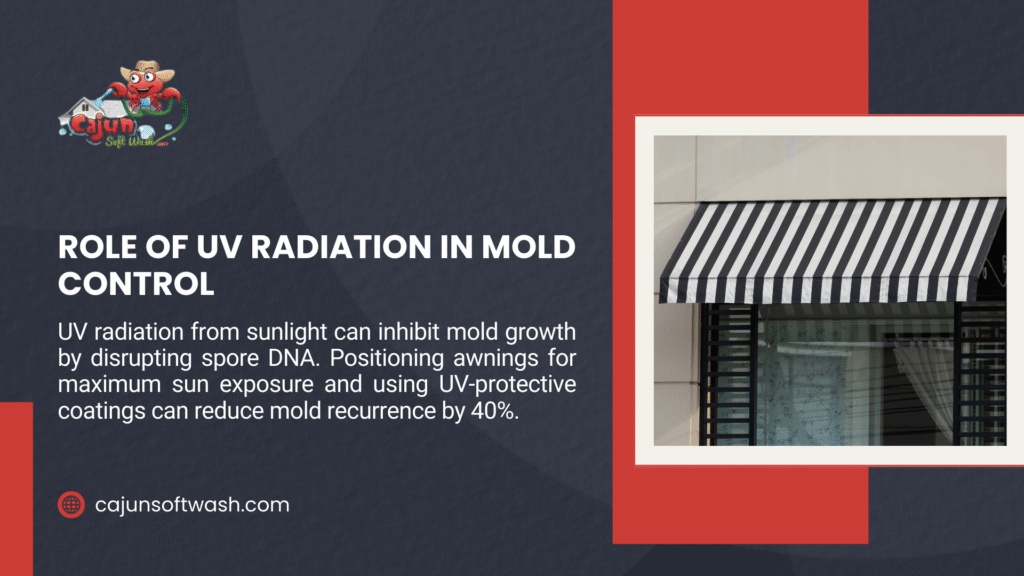
The Expensive Mistakes That Ruin Awnings
Pressure Washing Disaster
High pressure seems logical for stubborn mold, but it forces water deep into fabric weave and seams where it shouldn’t go. This trapped moisture creates ideal conditions for mold to return worse than before.
Pressure washing also tears weakened fabric and strips protective coatings that help prevent future mold growth.
Chemical Overkill
Bleach kills mold effectively, but it also breaks down fabric fibers and removes waterproof treatments. Many homeowners discover this after their “successful” mold removal leaves awnings faded, brittle, or prone to tearing.
Pool chemicals, toilet bowl cleaners, and other household products designed for hard surfaces are too harsh for fabric applications.
The Storage Mistake
Rolling up or retracting damp awnings after cleaning creates enclosed, humid environments where mold explodes. This mistake often results in mold problems worse than the original issue within days of “successful” cleaning.
When Professional Mold Removal Makes Sense
Some mold situations are beyond a reasonable DIY scope. Extensive growth covering large areas presents both safety and effectiveness challenges that professional equipment handles better.
High awnings or difficult-to-reach installations present safety risks that aren’t worth taking.
Professional services have the equipment and insurance to handle dangerous access situations safely.
Expensive specialty fabrics sometimes need specific mold treatment protocols that generic cleaning products can’t provide. Custom awnings, marine-grade materials, or antique fabrics benefit from professional expertise.
Health considerations matter too. Family members with respiratory issues, immune system problems, or mold allergies shouldn’t be exposed to disturbed spores during extensive cleaning projects.
Similar challenges arise with other exterior cleaning projects around the home. Professional awning cleaning uses specialized techniques that address humid climate challenges while protecting expensive materials.
Preventing Mold Return
Successfully removing existing mold is only half the battle. Humid climates mean mold spores are constantly present, waiting for the right conditions to establish new colonies.
Regular Maintenance Schedule
Monthly inspections catch mold growth while it’s still easy to handle. Look for early signs like musty odors, small discolored spots, or areas that stay damp longer than others.
Improving Air Circulation
Mold needs stagnant air to thrive. Ensure awnings have adequate ventilation underneath and aren’t positioned where air circulation is blocked by structures or landscaping.
Managing Moisture Sources
Address obvious moisture problems like clogged gutters, sprinkler overspray, or poor drainage that keep awnings damp longer than necessary.
Seasonal Deep Cleaning
Even well-maintained awnings benefit from thorough seasonal cleaning that addresses buildups before they become mold food sources.
The Health and Financial Reality
Moldy awnings affect more than just appearance. Those spores don’t stay outside – they drift into homes through open doors and windows, potentially affecting indoor air quality and family health.
From a financial perspective, proper mold removal extends awning life significantly. Quality awnings cost thousands to replace, making professional maintenance a smart investment when it prevents premature replacement.
Clean, well-maintained awnings also perform better functionally. They provide proper shade, reflect heat effectively, and contribute to energy savings that moldy, degraded fabric can’t match.
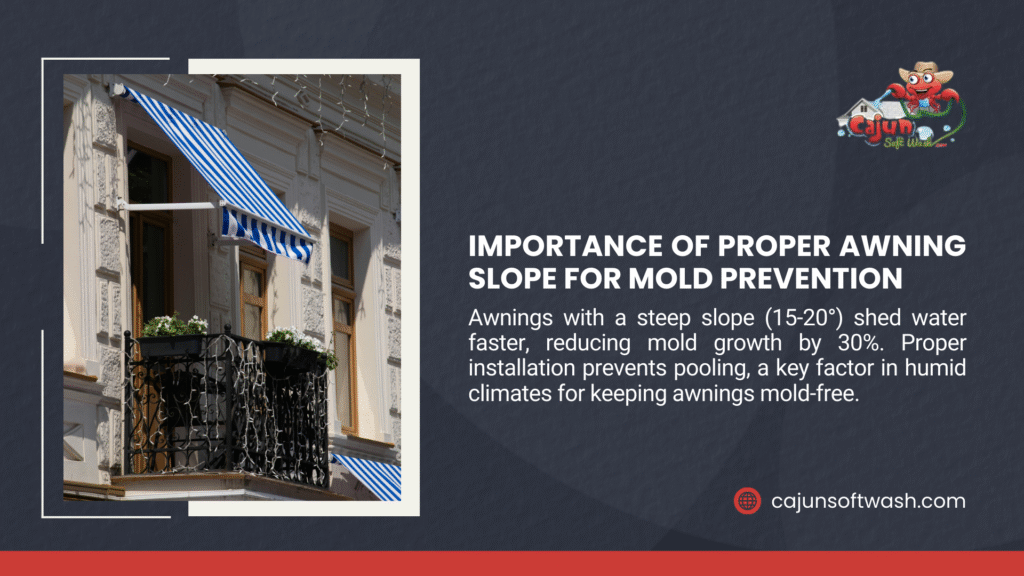
Professional Mold Removal That Lasts
Learning how to clean an awning with mold helps maintain your investment and family health, but when guaranteed results matter without damage risk, professional services deliver superior outcomes.
Professional mold removal goes beyond surface cleaning to address root causes and prevent rapid regrowth. The specialized equipment and solutions aren’t available to homeowners, and the experience to handle different fabric types safely comes from years of practice.
For comprehensive information about professional approaches, check out this detailed guide on how to clean an awning that covers various fabric types and cleaning challenges.
Or you can contact us for professional mold removal that protects awning investments while delivering results that last. Our Louisiana-based team understands exactly what it takes to win the war against awning mold in challenging humid climates.
For More:


